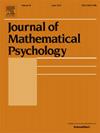随机二叉选择问题
IF 1.5
4区 心理学
Q2 MATHEMATICS, INTERDISCIPLINARY APPLICATIONS
引用次数: 0
摘要
经典的(到目前为止尚未解决的)随机二元选择问题是,在什么条件下,定义在选择对上的给定随机选择函数来自随机排序。对于最多两个排名被赋正概率的情况,我们提出了一个解决方案。这种情况是心理动机和有趣的应用程序。它在结构上不同于一般情况,因为由随机排序得到的选择函数不一定形成凸多面体,因此它们在原则上甚至不能用一组线性不等式来描述。本文章由计算机程序翻译,如有差异,请以英文原文为准。
The stochastic 2-binary choice problem
The classic (to date unsolved) stochastic binary choice problem asks under what conditions a given stochastic choice function defined on pairs of alternatives derives from a random ranking. We propose a solution to the problem for the case in which at most two rankings are assigned positive probability. This case is psychologically motivated and interesting for applications. It is structurally different from the general case in that the choice functions that are derived from a random ranking do not necessarily form a convex polytope, hence they are not even in principle described by a set of linear inequalities.
求助全文
通过发布文献求助,成功后即可免费获取论文全文。
去求助
来源期刊

Journal of Mathematical Psychology
医学-数学跨学科应用
CiteScore
3.70
自引率
11.10%
发文量
37
审稿时长
20.2 weeks
期刊介绍:
The Journal of Mathematical Psychology includes articles, monographs and reviews, notes and commentaries, and book reviews in all areas of mathematical psychology. Empirical and theoretical contributions are equally welcome.
Areas of special interest include, but are not limited to, fundamental measurement and psychological process models, such as those based upon neural network or information processing concepts. A partial listing of substantive areas covered include sensation and perception, psychophysics, learning and memory, problem solving, judgment and decision-making, and motivation.
The Journal of Mathematical Psychology is affiliated with the Society for Mathematical Psychology.
Research Areas include:
• Models for sensation and perception, learning, memory and thinking
• Fundamental measurement and scaling
• Decision making
• Neural modeling and networks
• Psychophysics and signal detection
• Neuropsychological theories
• Psycholinguistics
• Motivational dynamics
• Animal behavior
• Psychometric theory
 求助内容:
求助内容: 应助结果提醒方式:
应助结果提醒方式:


